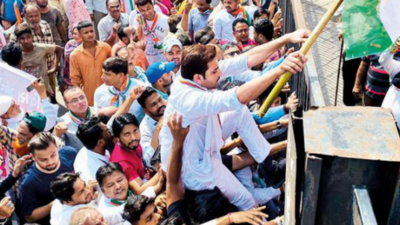- News
- City News
- ahmedabad News
- Basements flood as Ahmedabad Municipal Corporation waters down rule
Basements flood as Ahmedabad Municipal Corporation waters down rule

Ahmedabad Municipal Corporation (AMC) councillors of the Congress held a protest outside the civic body’s headquarters on Wednesday
AHMEDABAD: In 2002, the civic body made it compulsory for all housing societies to construct percolating wells, but more than 15,000 societies in the city are violating this rule. Every monsoon, about 934.4 billion litres of rainwater floods our streets. To divert this water to the Sabarmati, the AMC has laid just 37% of the city’s road network with stormwater lines over the past 20 years.
The city’s second line of defence is supposed to be formed by thousands of percolating wells in housing societies. Had they existed, at least 5-10% of the rainwater would have been diverted.
The AMC has failed to enforce its own rule and dishes out building-use permission (BU) to developers. Sources say that had the rule been imposed, stormwater management would have been better and many societies’ basements would have had a safeguard against inundation.
In 2018, the AMC sent notices to 1,209 housing societies and highrises over dysfunctional percolating wells or the lack of them. This year in April, municipal commissioner Lochan Sehra had announced that the AMC will offer 80% subsidy for percolating wells that are made within a particular budget size.
Sources say that in reality about 15,000 residential societies that got development permissions and BUs either don’t have percolating wells or have dysfunctional ones. The civic body has remained silent on the issue. In 2002, Ahmedabad Urban Development Authority (AUDA) had made it mandatory for private societies with more than 500 sq m of constructed area to create percolating wells for proper rainwater management. This rule was elaborated in 2014 Comprehensive General Development Control Regulations for Ahmedabad city. The rule was included in the new regulations issued in 2017 for the state. Applications for development permissions require proper design of percolation wells. The civic body is supposed to check whether developers have constructed percolation wells. In theory, developers are to be given BU permissions only if the wells are functional.
This rule is applicable to 95% of the buildings that have come up over the past two decades. Sources in the AMC said that most of these new buildings have emerged in areas that fall in the western part of the city stretching from Sarkhej to Chandkheda.
The AMC has issued BU permissions to these buildings despite being aware of faults in their design. Sources said that the civic body is supposed to frequently check whether the percolating wells are functional. They said that no such inspection is carried out. “In most buildings, the percolating wells are constructed in the margin areas. The developer has to construct a slope so that the rainwater flows into the well catch pit,” a senior AMC official. “The slopes are not made properly. So residential societies are entirely dependent on the AMC’s stormwater pipelines for managing rainwater.”
The official said that lack of political will to establish a punitive system of enforcement, the civic body ignores violations.
The city’s second line of defence is supposed to be formed by thousands of percolating wells in housing societies. Had they existed, at least 5-10% of the rainwater would have been diverted.
The AMC has failed to enforce its own rule and dishes out building-use permission (BU) to developers. Sources say that had the rule been imposed, stormwater management would have been better and many societies’ basements would have had a safeguard against inundation.
In 2018, the AMC sent notices to 1,209 housing societies and highrises over dysfunctional percolating wells or the lack of them. This year in April, municipal commissioner Lochan Sehra had announced that the AMC will offer 80% subsidy for percolating wells that are made within a particular budget size.
Sources say that in reality about 15,000 residential societies that got development permissions and BUs either don’t have percolating wells or have dysfunctional ones. The civic body has remained silent on the issue. In 2002, Ahmedabad Urban Development Authority (AUDA) had made it mandatory for private societies with more than 500 sq m of constructed area to create percolating wells for proper rainwater management. This rule was elaborated in 2014 Comprehensive General Development Control Regulations for Ahmedabad city. The rule was included in the new regulations issued in 2017 for the state. Applications for development permissions require proper design of percolation wells. The civic body is supposed to check whether developers have constructed percolation wells. In theory, developers are to be given BU permissions only if the wells are functional.
This rule is applicable to 95% of the buildings that have come up over the past two decades. Sources in the AMC said that most of these new buildings have emerged in areas that fall in the western part of the city stretching from Sarkhej to Chandkheda.
The AMC has issued BU permissions to these buildings despite being aware of faults in their design. Sources said that the civic body is supposed to frequently check whether the percolating wells are functional. They said that no such inspection is carried out. “In most buildings, the percolating wells are constructed in the margin areas. The developer has to construct a slope so that the rainwater flows into the well catch pit,” a senior AMC official. “The slopes are not made properly. So residential societies are entirely dependent on the AMC’s stormwater pipelines for managing rainwater.”
The official said that lack of political will to establish a punitive system of enforcement, the civic body ignores violations.
FOLLOW US ON SOCIAL MEDIA
FacebookTwitterInstagramKOO APPYOUTUBE
Start a Conversation
end of article









